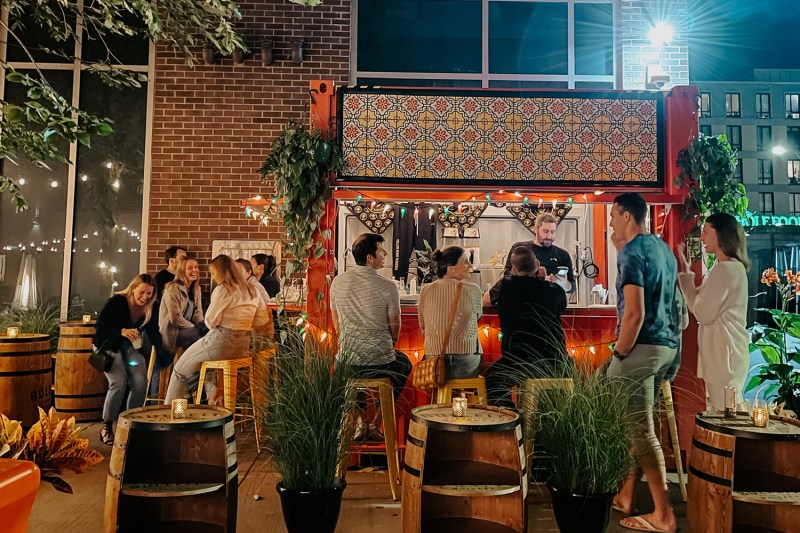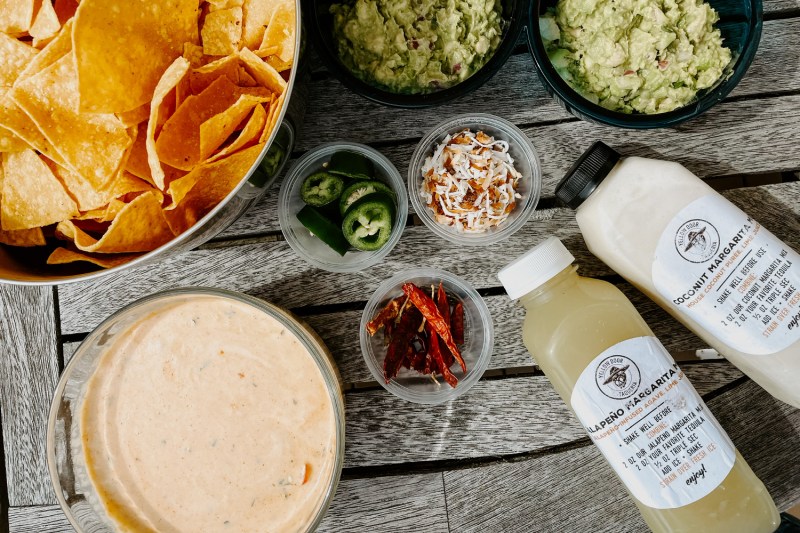The future of the bar as we know it is in Bean Town. It’s the container bar at Yellow Door Taqueria, a model establishment that’s managed to take the pandemic in stride. And it’s shaping the way bars are headed going forward.
The bar opened this summer in Boston’s South End. The menu includes specialty cocktails, a family of Margaritas, and even shots of mezcal. But it’s the nature of the bar itself, set in a shiny red container on a sprawling patio, that’s part of a bigger food and drinks trend.

“It was a creative and fun way to improve the experience of our guests that prefer to dine outside, that isn’t permanent or extremely expensive to execute,” says Colleen Hagerty, co-owner of Yellow Door Taqueria. “COVID protocols will forever be embedded in our current and future standard operations. The introduction of a container bar brings an indoor dining experience outside where many post-pandemic guests prefer to dine.”
Per the city’s regulations, the bar will stay open until December, treating guests to al fresco sipping, grub, and to-go cocktails. It’ll reopen again next year after the offseason (the restaurant will remain open, of course). The food menu is taco-heavy, inspired by the cuisines of California and Mexico. It’s the kind of food and drinks you want to eat outside, if you can, as it’s evocative of a sun-parched street in Mexico City.
What makes it the sign of the times? In short, nailing all of the little things that restaurants have had to do in order to stay relevant during the pandemic. That includes a welcoming outdoor dining space, creative workarounds (a container bar, instead of an expensive buildout), forward thinking, building a strong staff, and, of course, to-go items. “Takeout is the new normal and we would much prefer our guests to have the opportunity to purchase our craft beverages to help keep those sales in house,” Hagerty says. “Takeout was and is a lifeline in navigating the pandemic.”
It’s no wonder the bar has been a success, with well-crafted drinks and an environment that’s at once fun and friendly. Restaurants all over the nation have adapted in similar fashion, putting loans to work by way of innovative patio areas, alleyways, rooftops, and more. Yellow Door has not only endured the last few years, but shuffled gracefully with it, embracing a dining crowd that’s forever changed.

So what advice would Yellow Door offer to other restaurants trying to get by? “Invest in your front-of-house and back-of-house teams and elements of the business that will make you successful long term. You truly need to think three years out as so many new restaurants fail within that time frame,” Hagerty says.
She’s been to auctions lately where expensive equipment from failed restaurant enterprises are sold, like $1,000 bar stools and $10,000 coffee makers. “The $1,000 stool isn’t going to make poorly executed menu items taste better or improve poor guest service,” she says. “A $40 martini glass won’t fix a poorly made drink by an untrained bartender.”
These days, we’re craving the restaurant experience, perhaps more than ever. That experience is a combination of factors, some old (great cuisine and service), some born from the pandemic (al fresco options, social distancing). We’ve lost a lot of great ones since 2020, but many of the best are navigating forward smartly. Patrons have it pretty good at the moment and that’s got us pretty excited about eating and imbibing in the future.
“Restaurants reopening after the height of COVID brought so much happiness and joy to people that lost pieces of themselves to the quarantine stage of the pandemic,” Hagerty says. “Sharing meals together is many people’s love language. Date nights, birthdays, family members flying in to visit—the first question is always ‘where should we eat?’ Restaurants give cities their energy and there was a real loneliness without them during COVID.”


